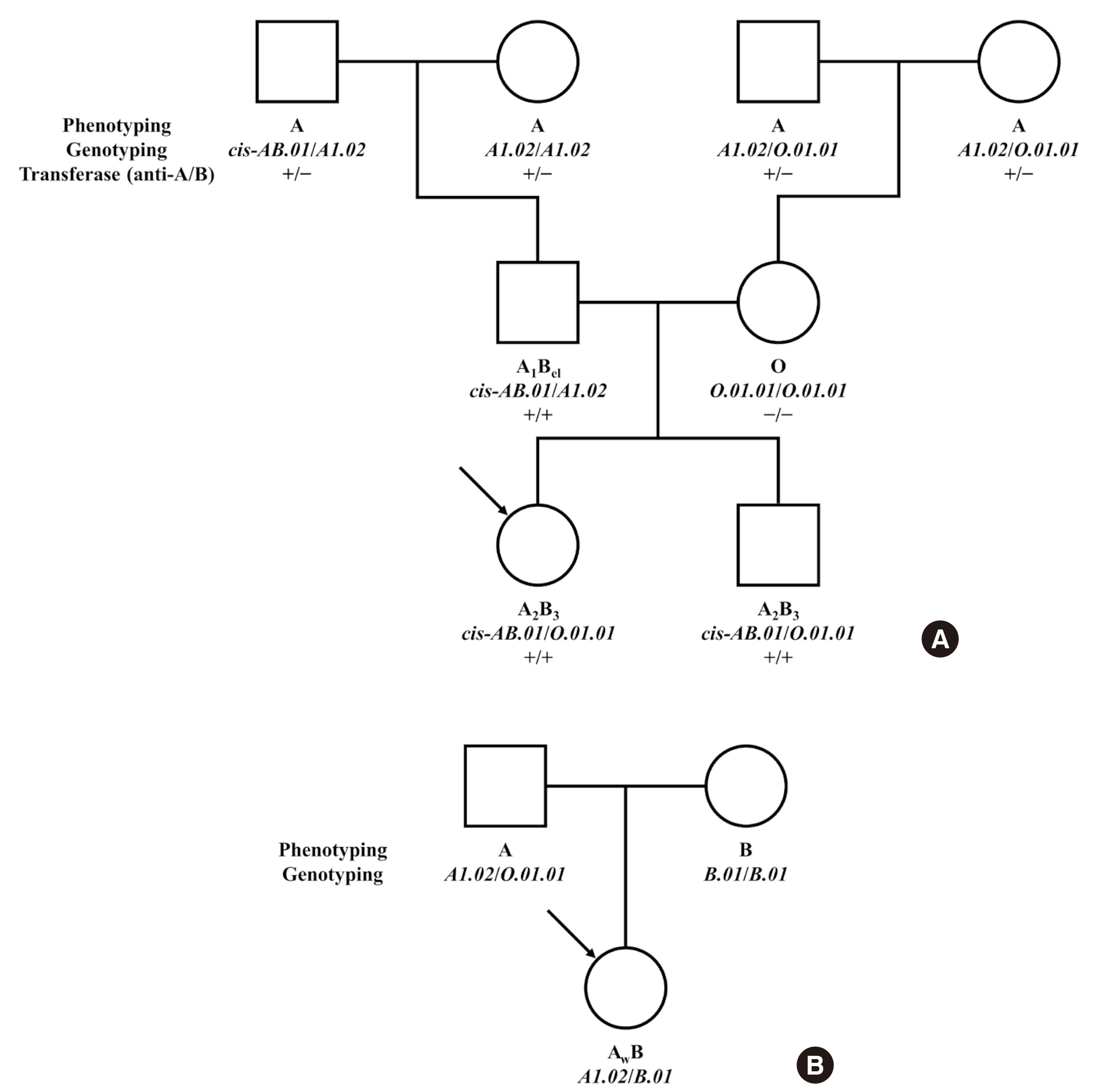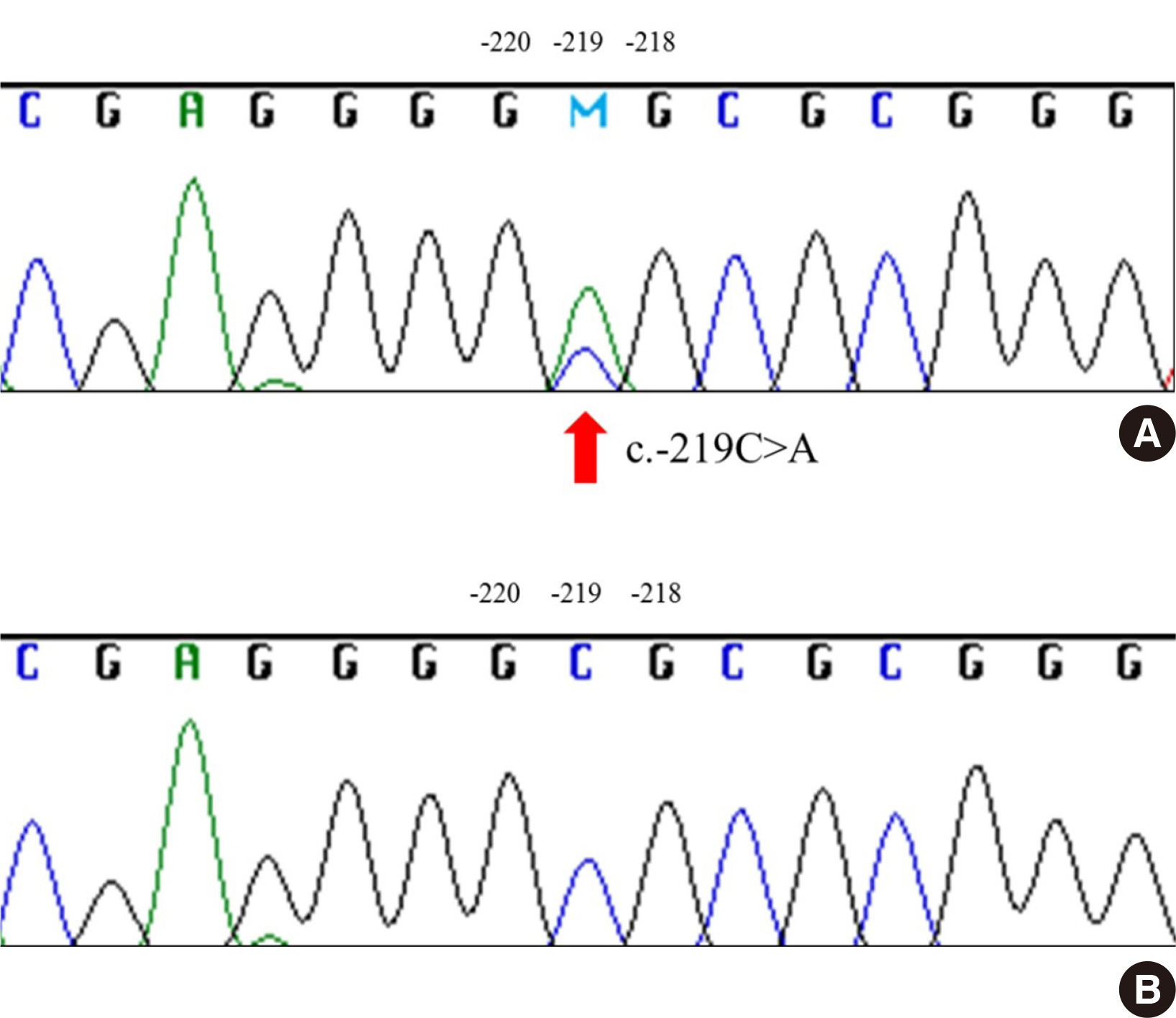Lab Med Online.
2023 Apr;13(2):97-102. 10.47429/lmo.2023.13.2.97.
Various ABO Genotyping-phenotyping Results for ABO Blood Group Discrepancy: A Retrospective Study
- Affiliations
-
- 1Department of Laboratory Medicine, Seoul St. Mary’s Hospital, College of Medicine, The Catholic University of Korea, Seoul, Korea
- 2Department of Laboratory Medicine, Incheon St. Mary’s Hospital, College of Medicine, The Catholic University of Korea, Incheon, Korea
- KMID: 2552732
- DOI: http://doi.org/10.47429/lmo.2023.13.2.97
Abstract
- The ABO system remains the most important blood group classification system in transfusion medicine. ABO serology testing requires both forward and reverse typing as each grouping result validates the other, and ABO discrepancies must be resolved in the clinical laboratory. ABO genotyping has served as an independent tool in accurate blood group determination. This report retrospectively analyzes the ABO grouping results of 47 blood samples from two medical institutions. Various genotype-phenotype results were categorized based on correlations reported by previous investigators, and patients’ medical records were reviewed for conditions that may have affected the results. The frequencies of genotype-phenotype matches and genotype-phenotype mismatches were 72.3% (34/47 cases) and 27.7% (13/47cases), respectively. The Cis-AB alleles (23 cases) were the most prevalent cause of ABO discrepancies. Red cell A or B antigen losses in patients with hematologic disorders, malignancy, and pregnancy were genetically confirmed. A pedigree study revealed a father-son pair with the same genotype showing differing phenotypes, and whole exon sequencing including promoter region revealed a single-point mutation in the promoter region in one of the two patients. By directing sequencing of the full ABO coding region, including the promoter, in the analysis, we aimed to determine the potential regulatory role of a mutation in the promoter region in ABO gene expression.
Keyword
Figure
Reference
-
1. Ogasawara K, Yabe R, Uchikawa M, Saitou N, Bannai M, Nakata K, et al. 1996; Molecular genetic analysis of variant phenotypes of the ABO blood group system. Blood. 88:2732–7. DOI: 10.1182/blood.V88.7.2732.bloodjournal8872732. PMID: 8839869.2. Cho D, Kim SH, Jeon MJ, Choi KL, Kee SJ, Shin MG, et al. 2004; The serological and genetic basis of the cis-AB blood group in Korea. Vox Sang. 87:41–3. DOI: 10.1111/j.1423-0410.2004.00528.x. PMID: 15260821.3. Yoshida A. 1981; Genetic mechanism of blood group (ABO)-expression. Acta Biol Med Ger. 40:927–41.4. Yoshida A, Yamaguchi H, Okubo Y. 1980; Genetic mechanism of cis-AB inheritance. II. Cases associated with structural mutation of blood group glycosyltransferase. Am J Hum Genet. 32:645–50.5. Yoshida A, Yamaguchi H, Okubo Y. 1980; Genetic mechanism of cis-AB inheritance. I. A case associated with unequal chromosomal crossing over. Am J Hum Genet. 32:332–8.6. Yamaguchi H. 1973; A review of cis AB blood. Jinrui Idengaku Zasshi. 18:1–9.7. Chun S, Choi S, Yu H, Cho D. 2019; Cis-AB, the blood group of many faces, is a conundrum to the novice eye. Ann Lab Med. 39:115–20. DOI: 10.3343/alm.2019.39.2.115. PMID: 30430772. PMCID: PMC6240514.8. Heo WY, Chung YN, Kim TY, Yu H, Bae JC, Kim H, et al. 2021; Analysis of ABO grouping discrepancies among patients from a tertiary hospital in Korea. Transfus Apher Sci. 60:103230. DOI: 10.1016/j.transci.2021.103230. PMID: 34400096.9. Anukul N, Leetrakool N, Tanan P, Palacajornsuk P, Klangsinsirikul P. 2018; Mixed-field agglutination observed in column agglutination testing is not always associated with the A3 subgroup. Immunohematology. 34:49–56. DOI: 10.21307/immunohematology-2018-009. PMID: 29989419.10. Olsson ML, Westman JS. Cohn CS, Delaney M, editors. 2020. The ABO system (001). Technical manual. 20th ed. p. 302. Bethesda, MD: Association for the Advancement of Blood & Biotherapies.11. Yu LC, Twu YC, Chou ML, Chang CY, Wu CY, Lin M. 2002; Molecular genetic analysis for the B3 allele. Blood. 100:1490–2. DOI: 10.1182/blood-2002-01-0188. PMID: 12149236.12. Seltsam A, Das Gupta C, Bade-Doeding C, Blasczyk R. 2006; A weak blood group A phenotype caused by a translation-initiator mutation in the ABO gene. Transfusion. 46:434–40. DOI: 10.1111/j.1537-2995.2006.00740.x. PMID: 16533287.13. Kominato Y, Tsuchiya T, Hata N, Takizawa H, Yamamoto F. 1997; Transcription of human ABO histo-blood group genes is dependent upon binding of transcription factor CBF/NF-Y to minisatellite sequence. J Biol Chem. 272:25890–8. DOI: 10.1074/jbc.272.41.25890. PMID: 9325321.14. Olsson ML, Chester MA. 2001; Polymorphism and recombination events at the ABO locus: a major challenge for genomic ABO blood grouping strategies. Transfus Med. 11:295–313. DOI: 10.1046/j.1365-3148.2001.00320.x. PMID: 11532186.15. Isa K, Yamamuro Y, Ogasawara K, Yabe R, Ogiyama Y, Ito S, et al. 2016; Presence of nucleotide substitutions in the ABO promoter in individuals with phenotypes A3 and B3. Vox Sang. 110:285–7. DOI: 10.1111/vox.12363. PMID: 26529276.16. Hellberg A, Hult AK, Moser I, Tomaz B, Rodrigues M, Olsson ML. 2019; A novel single-nucleotide substitution in the proximal ABO promoter gives rise to the B3 phenotype. Transfusion. 59:E1–3. DOI: 10.1111/trf.15457.17. Olsson ML, Irshaid NM, Hosseini-Maaf B, Hellberg A, Moulds MK, Sareneva H, et al. 2001; Genomic analysis of clinical samples with serologic ABO blood grouping discrepancies: identification of 15 novel A and B subgroup alleles. Blood. 98:1585–93. DOI: 10.1182/blood.V98.5.1585. PMID: 11520811.
- Full Text Links
- Actions
-
Cited
- CITED
-
- Close
- Share
- Similar articles
-
- Clinical Application of ABO Genotyping: 5-Year Experience from a Single Tertiary Care Center in Korea
- Application of ABO genotyping in determination of ABO subgroups
- Detection of an AB(weak) Blood Group by Genotyping
- ABO Genotyping in Three Cases of Bx Blood Phenotype
- Considerations on ABO Genotyping Results: Lessons from ABO*AW.10 Allele Cases



